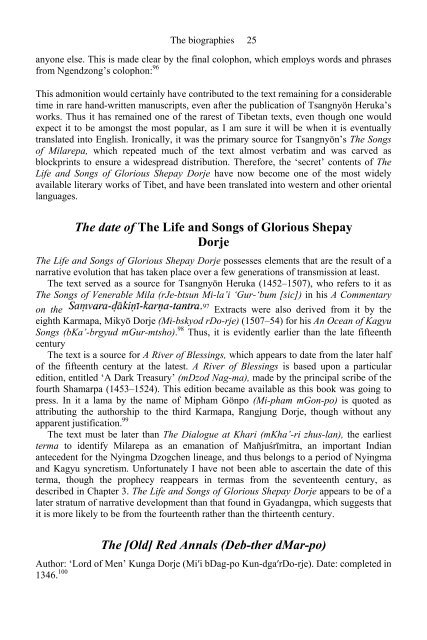The Biographies of Rechungpa: The Evolution of a Tibetan ...
The Biographies of Rechungpa: The Evolution of a Tibetan ...
The Biographies of Rechungpa: The Evolution of a Tibetan ...
Create successful ePaper yourself
Turn your PDF publications into a flip-book with our unique Google optimized e-Paper software.
<strong>The</strong> biographies 25<br />
anyone else. This is made clear by the final colophon, which employs words and phrases<br />
from Ngendzong’s colophon: 96<br />
This admonition would certainly have contributed to the text remaining for a considerable<br />
time in rare hand-written manuscripts, even after the publication <strong>of</strong> Tsangnyön Heruka’s<br />
works. Thus it has remained one <strong>of</strong> the rarest <strong>of</strong> <strong>Tibetan</strong> texts, even though one would<br />
expect it to be amongst the most popular, as I am sure it will be when it is eventually<br />
translated into English. Ironically, it was the primary source for Tsangnyön’s <strong>The</strong> Songs<br />
<strong>of</strong> Milarepa, which repeated much <strong>of</strong> the text almost verbatim and was carved as<br />
blockprints to ensure a widespread distribution. <strong>The</strong>refore, the ‘secret’ contents <strong>of</strong> <strong>The</strong><br />
Life and Songs <strong>of</strong> Glorious Shepay Dorje have now become one <strong>of</strong> the most widely<br />
available literary works <strong>of</strong> Tibet, and have been translated into western and other oriental<br />
languages.<br />
<strong>The</strong> date <strong>of</strong> <strong>The</strong> Life and Songs <strong>of</strong> Glorious Shepay<br />
Dorje<br />
<strong>The</strong> Life and Songs <strong>of</strong> Glorious Shepay Dorje possesses elements that are the result <strong>of</strong> a<br />
narrative evolution that has taken place over a few generations <strong>of</strong> transmission at least.<br />
<strong>The</strong> text served as a source for Tsangnyön Heruka (1452–1507), who refers to it as<br />
<strong>The</strong> Songs <strong>of</strong> Venerable Mila (rJe-btsun Mi-la’i ‘Gur-‘bum [sic]) in his A Commentary<br />
97<br />
on the<br />
Extracts were also derived from it by the<br />
eighth Karmapa, Mikyö Dorje (Mi-bskyod rDo-rje) (1507–54) for his An Ocean <strong>of</strong> Kagyu<br />
Songs (bKa’-brgyud mGur-mtsho). 98 Thus, it is evidently earlier than the late fifteenth<br />
century<br />
<strong>The</strong> text is a source for A River <strong>of</strong> Blessings, which appears to date from the later half<br />
<strong>of</strong> the fifteenth century at the latest. A River <strong>of</strong> Blessings is based upon a particular<br />
edition, entitled ‘A Dark Treasury’ (mDzod Nag-ma), made by the principal scribe <strong>of</strong> the<br />
fourth Shamarpa (1453–1524). This edition became available as this book was going to<br />
press. In it a lama by the name <strong>of</strong> Mipham Gönpo (Mi-pham mGon-po) is quoted as<br />
attributing the authorship to the third Karmapa, Rangjung Dorje, though without any<br />
apparent justification. 99<br />
<strong>The</strong> text must be later than <strong>The</strong> Dialogue at Khari (mKha’-ri zhus-lan), the earliest<br />
terma to identify Milarepa as an emanation <strong>of</strong> Mañjuśrīmitra, an important Indian<br />
antecedent for the Nyingma Dzogchen lineage, and thus belongs to a period <strong>of</strong> Nyingma<br />
and Kagyu syncretism. Unfortunately I have not been able to ascertain the date <strong>of</strong> this<br />
terma, though the prophecy reappears in termas from the seventeenth century, as<br />
described in Chapter 3. <strong>The</strong> Life and Songs <strong>of</strong> Glorious Shepay Dorje appears to be <strong>of</strong> a<br />
later stratum <strong>of</strong> narrative development than that found in Gyadangpa, which suggests that<br />
it is more likely to be from the fourteenth rather than the thirteenth century.<br />
<strong>The</strong> [Old] Red Annals (Deb-ther dMar-po)<br />
Author: ‘Lord <strong>of</strong> Men’ Kunga Dorje (Mi′i bDag-po Kun-dga′rDo-rje). Date: completed in<br />
1346. 100











